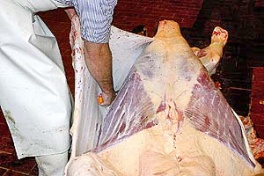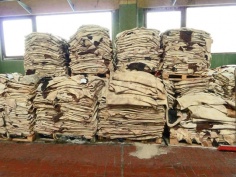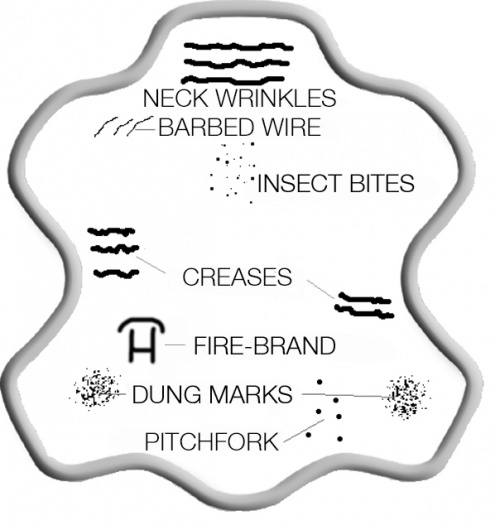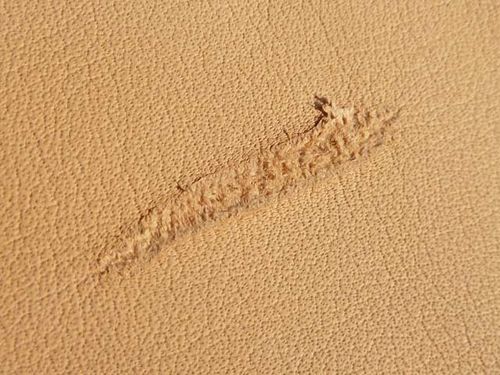Difference between revisions of "Rawhide dealers - Skin collectors"
| (11 intermediate revisions by one user not shown) | |||
| Line 11: | Line 11: | ||
==Rawhide dealers - Skin collectors== | ==Rawhide dealers - Skin collectors== | ||
| − | + | A slaughterhouse slaughters animals of every kind and age, resulting in a wide variety of [[Rawhide|rawhides]]. Tanneries specialise in certain [[types of leather]]. Slaughterhouses and [[tannery|tanneries]] also have different capacities. | |
| − | + | In most cases, the skins do not go directly from the slaughterhouse to the [[tannery]]. Rawhide dealers or skin collectors buy the hides, sort them by [[exotic leather|species]], sex (the [[car leather|car industry]] uses exclusively bull skins) and weight (affects the [[Measures and weights|size of the skin]]). They then cut the edges of the rawhides and skins and [[Preservation by drying, salting or freezing|preserve]] them. | |
| − | + | Tanners often buy from multiple rawhide dealers at the same time. 10-20 rawhide dealers for a [[tannery]] is not uncommon. | |
| − | + | However, larger [[tannery|tanneries]] also buy directly from slaughterhouses and process the raw material fresh without [[Preservation by drying, salting or freezing|intermediate preservation]]. | |
| − | + | Decades ago, local slaughterhouses and butchers performed these tasks. Today however, the meat industry is dominated by large farms. Due to the size of these farms and the greater demand for hides by the growing [[car leather|car industry]], rawhide dealers and agro companies are in a much stronger position. | |
| − | + | Raw material prices are rising steadily, and the [[tannery|tanneries]] and [[Leather dealer|leather traders]] are constantly faced with a constant dilemma of whether to pass these cost increases to their buyers or not. If prices rise too much, manufacturers can switch to substitute materials, such as fabrics or [[Imitation leather|synthetic leather]]. According to statements of leather experts, for the tanner (the buyer) the costs of raw materials are the largest single cost and historically estimated between 30-50% of the total costs. | |
| − | + | The [[leather quality|quality of the hides]] can vary depending on the bovine species, origin (a rule of thumb is that hides from above the 37th parallel are of better quality), sex, age, nutrition and type of livestock farming. Tanneries put in a great deal of effort to secure supplier sources, which deliver consistently [[leather quality|good quality]]. Leather with bad characteristics or many [[Natural markings on leather|skin damages]] can quickly [[leather cutting waste|add to wastage]] and reduce the number of sellable stock for dealers. | |
<p align=center> | <p align=center> | ||
| − | [[bild:Leather-damages-natural-marks-01.jpg| | + | [[bild:Leather-damages-natural-marks-01.jpg|500px]] |
| − | [[bild: | + | </p> |
| + | <p align=center> | ||
| + | [[bild:Skin damage 11.jpg|500px]] | ||
</p> | </p> | ||
<p align=center> | <p align=center> | ||
''The unfulfillable desire of every [[tannery]] are [[Rawhide|Rawhides]] without [[Natural markings on leather|natural markings]].''<br></p> | ''The unfulfillable desire of every [[tannery]] are [[Rawhide|Rawhides]] without [[Natural markings on leather|natural markings]].''<br></p> | ||
<p> </p> | <p> </p> | ||
| − | |||
| − | |||
| − | |||
| − | |||
| − | |||
| − | |||
==Additional information== | ==Additional information== | ||
Latest revision as of 20:12, 1 February 2023
Rawhide dealers - Skin collectors
A slaughterhouse slaughters animals of every kind and age, resulting in a wide variety of rawhides. Tanneries specialise in certain types of leather. Slaughterhouses and tanneries also have different capacities.
In most cases, the skins do not go directly from the slaughterhouse to the tannery. Rawhide dealers or skin collectors buy the hides, sort them by species, sex (the car industry uses exclusively bull skins) and weight (affects the size of the skin). They then cut the edges of the rawhides and skins and preserve them.
Tanners often buy from multiple rawhide dealers at the same time. 10-20 rawhide dealers for a tannery is not uncommon.
However, larger tanneries also buy directly from slaughterhouses and process the raw material fresh without intermediate preservation.
Decades ago, local slaughterhouses and butchers performed these tasks. Today however, the meat industry is dominated by large farms. Due to the size of these farms and the greater demand for hides by the growing car industry, rawhide dealers and agro companies are in a much stronger position.
Raw material prices are rising steadily, and the tanneries and leather traders are constantly faced with a constant dilemma of whether to pass these cost increases to their buyers or not. If prices rise too much, manufacturers can switch to substitute materials, such as fabrics or synthetic leather. According to statements of leather experts, for the tanner (the buyer) the costs of raw materials are the largest single cost and historically estimated between 30-50% of the total costs.
The quality of the hides can vary depending on the bovine species, origin (a rule of thumb is that hides from above the 37th parallel are of better quality), sex, age, nutrition and type of livestock farming. Tanneries put in a great deal of effort to secure supplier sources, which deliver consistently good quality. Leather with bad characteristics or many skin damages can quickly add to wastage and reduce the number of sellable stock for dealers.
The unfulfillable desire of every tannery are Rawhides without natural markings.
Additional information












 a kotori web solution
a kotori web solution